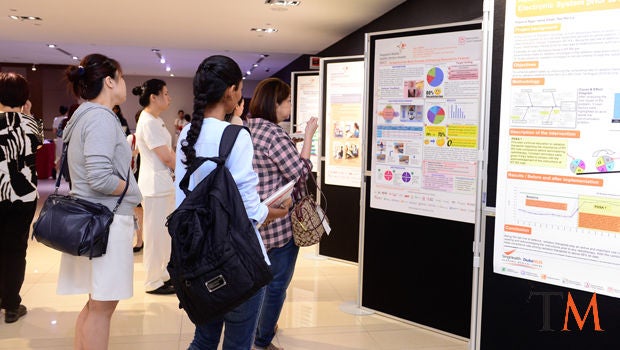
Participants at the 2017 SingHealth Quality and Innovation Day (SQID) shared and learnt about best practices in patient safety and quality innovation that go towards providing better care.
Enshrined in the Hippocratic Oath are the words “Primum non nocere”, which means “first do no harm”. All healthcare professionals must subscribe to this – that right from the beginning of their healthcare journeys, the safety of our patients is sacred.
If we do not make the target for patient-harm cases as zero, then we as healthcare professionals have made a choice to compromise the safety of patients. A review of England’s National Health Service at South Central found that 43.5% of adverse events in the hospital could have been prevented.

Prof Kenneth Kwek was plenary speaker for SQID 2017.
Teamwork and accountability
Luckily we are not alone. Advancements in technology, along with increasingly rigorous training have placed us very close to zero harm. In the modern healthcare system, professionals and systems work hand in hand to perfect patient safety. But good systems and processes alone are not enough.
Ultimately, it is down to each professional doing what they are trained to do, as an individual and as a team. This is where personal and collaborative accountability come in.
Personal accountability is where individuals are committed to carrying out their duties to the best of their abilities all the time, constantly reviewing and strengthening one’s processes. Collaborative accountability calls for open and honest communication between team members to keep one another in check, fostering greater teamwork and a culture of reliability.
In both cases, accountability should never become a reason for punishment or rebuke. A high level of accountability contributes greatly to a culture of zero harm.
What it takes to get to zero harm
Three key aspects support healthcare professionals in achieving zero harm: A strong commitment from leadership, a learning and understanding culture towards patient safety, and clear measures to track progress.
1. Leadership commitment
Efficiency must not come at the cost of safety. To that end, leaders must set an example for their staff and never compromise. They have to find time to discuss and solve patient safety issues thoroughly, from clinical areas of concern to all areas of operations.
2. Culture building
There are two areas of culture that needs to be built in our healthcare institutions. The first is leadership at all levels, meaning everyone needs to take responsibility to be accountable, make things safer and take the initiative to propose improvements. These actions are not reserved for senior or higher-ranking staff members only. Passivity will only increase the chances of patient harm.
Next is the culture of speaking up, meaning every staff member can and should speak up when they see something that is not right. With commitment from leaders, issues brought up will have follow-up and action. It is up to everyone in the organisation to create an open and honest reporting culture.
3. Measure and track
Setting up zero harm dashboards and charts allows for the tracking and implementation of appropriate measures to attain zero harm. Dashboards make these goals visible to all staff and they provide a measurement as to how well the team is doing.
While we cannot expect individuals to be perfect, we can however create a perfect system that acts as a "buffer" to ensure an error causes only minimum or almost zero harm to patients. This can be further improved by practicing individual and team accountability.
Together towards Zero Harm
Here are some of the initiatives that have led to better patient safety in SingHealth.
Leadership Rounding at KKH
KKH leaders regularly visit the wards to meet and dialogue with the care team and patients. Through these sessions, the leaders receive feedback and ideas to help improve caregiver and patient experiences. 167 issues have been recorded so far, which has led to the formation of 33 work groups that have worked towards revolving 54 of the issues.
SGH Ambulatory Endoscopy Centre (AEC)
To increase the level of safety, the AEC puts in measures to ensure they are running at sufficient capacity for optimal patient monitoring. Routine wiping of the telescopic screens, reduced use of reversal agents, physical separation of dirty and clean areas, as well as using dehumidified storage further reduces risk to their patients.
Patient Safety Leads (PSL) at KKH
Comprising of 21 medical, 14 nursing, and 27 admin and support staff, the PSLs are involved in an intensive engagement programme consisting of bi-monthly sharing, rounds, training and patient safety initiatives.
SGH Infection Prevention & Control (IPC)
The IPC has a long history for on-going education programmes and events to raise awareness and competency for patient safety and hand hygiene. Some of their initiatives include an infection control intranet site, annual workshops for staff, participation in overseas training, use of posters and visual cues in wards, and wall and bus murals.













 Get it on Google Play
Get it on Google Play